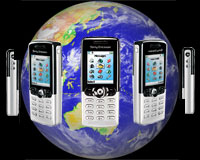 Global mobile shipments are set to hit one billion this year for the first time.
Global mobile shipments are set to hit one billion this year for the first time.
According to researchers IDC, a total of 254.9 million units were shipped in the third quarter of 2006, up 7.9 per cent from the previous quarter and a hefty leap of 21 per cent from the same quarter in 2005.
IDC’s Worldwide Quarterly Mobile Phone Tracker saw record performances from all top five top industry vendors during the first three quarters of 2006.
“Shipping nearly a billion units in a single year is a significant milestone, but just as important is the journey it takes to get there,” mused Ramon Llamas, research analyst with IDC’s Worldwide Mobile Phone Tracker.
“Emerging markets have presented tremendous opportunity for vendors to provide users with their first handsets, and some users may already be looking to upgrade to another phone. Similarly, replacement handsets are a popular option for those in mature markets, especially as new features such as music have gained momentum,” he added.
Ryan Reith, research analyst with IDC’s Worldwide Mobile Phone Tracker noted that, “the strong growth in the third quarter was very comparable to the growth we saw in 3Q05, as the trend of vendors and carriers working to prep for the holiday season begins.”
“Handsets that provide music functionality are now very visible in the industry. Mature markets are at a point where it is worthwhile for the carriers to launch these devices with strong marketing campaigns behind them, knowing that consumers are willing and ready to use their device as a music player as well as a phone,” Reith added.
The big boys break records
Nokia turned in another superlative performance, exceeding expectations and setting a new industry record by shipping 88.5 million units in the third quarter, cruising past its previous record by 4.8 million units, with the telecoms giant reporting double digit growth in the Far East, Europe, US and Chinese markets.
Records were also broken at second-placed Motorola, who enjoyed their sixth straight quarter notching up growth of around 40 per cent or better, helped on by the success of their RAZR phone.
Samsung managed to shift thirty million units in a quarter for the first time, while the number four vendor, Sony Ericsson notched up a healthy twenty million units.
 With ne’er a parp on their usual raucous PR trumpet, Samsung have quietly shuffled out two updates to its Q1 ultra mobile Origami PC range.
With ne’er a parp on their usual raucous PR trumpet, Samsung have quietly shuffled out two updates to its Q1 ultra mobile Origami PC range. 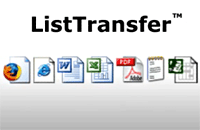 Weighing 1.7 pounds, it’s light enough to carry around for a few hours which is a good thing because that’s when the battery will conk out (battery life is measured at a rather disappointing three hours.)
Weighing 1.7 pounds, it’s light enough to carry around for a few hours which is a good thing because that’s when the battery will conk out (battery life is measured at a rather disappointing three hours.) 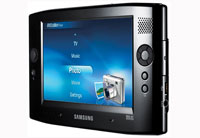 The other new model – the Q1b – uses a cheaper Via Technologies’ C7 1GHz processor, and is fitted with a 40 GB hard disk and 512 MB RAM.
The other new model – the Q1b – uses a cheaper Via Technologies’ C7 1GHz processor, and is fitted with a 40 GB hard disk and 512 MB RAM. 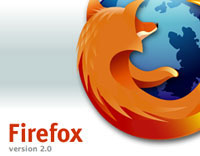 The final version of the Firefox 2.0 browser is expected to be released into the wild today.
The final version of the Firefox 2.0 browser is expected to be released into the wild today. 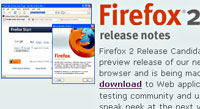 “If your browser needs a restart or the OS asks you to reboot, losing all of those web pages and content is pretty disruptive,” commented Mozilla VP of products Christopher Beard. Ain’t that the truth, Chris!
“If your browser needs a restart or the OS asks you to reboot, losing all of those web pages and content is pretty disruptive,” commented Mozilla VP of products Christopher Beard. Ain’t that the truth, Chris!  Set for a beta launch this month, Scrybe looks to be a ground-breaking online organiser if it lives up to the claims made in the promotional video posted on YouTube.
Set for a beta launch this month, Scrybe looks to be a ground-breaking online organiser if it lives up to the claims made in the promotional video posted on YouTube.  Web snippets – complete with bookmarks, graphics and text formatting – can be copied into a categorised Thought Pad interface and integrated with calendar events and To Dos, with multi page documents browsed via a sleek, pop up graphic navigation pane.
Web snippets – complete with bookmarks, graphics and text formatting – can be copied into a categorised Thought Pad interface and integrated with calendar events and To Dos, with multi page documents browsed via a sleek, pop up graphic navigation pane. 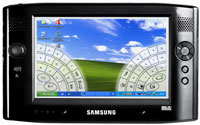 What we think so far
What we think so far Although the online demo looks amazing, we’ve seen far too many slick presentations be followed up by a hideous kludge of a program, so we’ve signed up to the beta trial and will hopefully be able to give you our hands-on verdict soon.
Although the online demo looks amazing, we’ve seen far too many slick presentations be followed up by a hideous kludge of a program, so we’ve signed up to the beta trial and will hopefully be able to give you our hands-on verdict soon.  UK Internet shoppers are spending up to 50 per cent more on electrical goods than they would on the High Street, according to new research.
UK Internet shoppers are spending up to 50 per cent more on electrical goods than they would on the High Street, according to new research. 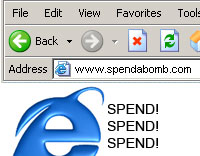 Not surprisingly, popular consumer products like hard drives and mp3 players have been big movers, but GFK also noted that consumers are increasingly shelling out for more diverse products online, such as bread makers and dishwashers.
Not surprisingly, popular consumer products like hard drives and mp3 players have been big movers, but GFK also noted that consumers are increasingly shelling out for more diverse products online, such as bread makers and dishwashers.  Coming straight from the you-must-be-having-a-laugh folder, news reaches us that the Los Angeles Scout group is introducing a new merit award — the Respecting Copyright Patch. We kid you not.
Coming straight from the you-must-be-having-a-laugh folder, news reaches us that the Los Angeles Scout group is introducing a new merit award — the Respecting Copyright Patch. We kid you not.  European mobile phone users are far more likely to use their handsets to access the web than their US counterparts, according to a new comScore Networks study.
European mobile phone users are far more likely to use their handsets to access the web than their US counterparts, according to a new comScore Networks study.  Portal sites were the most popular destinations for mobile surfers, with Google, Yahoo! and MSN leading the way, with branded Web sites set up by the phone operators, such as Vodafone, o2 and T-Mobile also proving a hit.
Portal sites were the most popular destinations for mobile surfers, with Google, Yahoo! and MSN leading the way, with branded Web sites set up by the phone operators, such as Vodafone, o2 and T-Mobile also proving a hit. 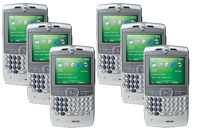 As the smartphone market continues to explode, Microsoft has revealed its bullish ambitions to keep on doubling sales, year on year.
As the smartphone market continues to explode, Microsoft has revealed its bullish ambitions to keep on doubling sales, year on year. According to research firm
According to research firm  It looks like the smartphone market is going to heat up in coming months too, with Research In Motion’s new
It looks like the smartphone market is going to heat up in coming months too, with Research In Motion’s new 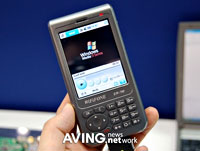 Currently causing something of a stir on the floor of the Korea Electronics Show is the WiFiFone EW-700, a Wi-Fi-enabled VoIP smartphone running Windows Mobile.
Currently causing something of a stir on the floor of the Korea Electronics Show is the WiFiFone EW-700, a Wi-Fi-enabled VoIP smartphone running Windows Mobile. 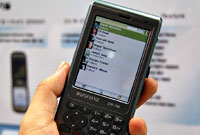 The EW-700, looks a fairly plain, clunky beast too – in fact the photos we’ve seen have something of a pre-production air to them – but it’s not short of features.
The EW-700, looks a fairly plain, clunky beast too – in fact the photos we’ve seen have something of a pre-production air to them – but it’s not short of features.  We’re yet to get full specs either, but the screen looks like a 320 x 240 pixels jobbie to us, and there’s also a 2-megapixel camera with camcorder function onboard, a voice recorder, hardware MPEG engine offering full frame video and Wi-Fi and infrared connectivity.
We’re yet to get full specs either, but the screen looks like a 320 x 240 pixels jobbie to us, and there’s also a 2-megapixel camera with camcorder function onboard, a voice recorder, hardware MPEG engine offering full frame video and Wi-Fi and infrared connectivity. 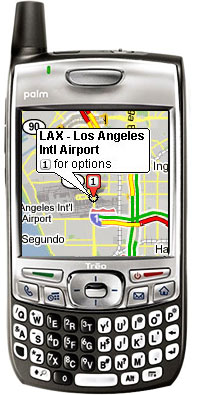 Although it was announced as part of the forthcoming Palm Treo 680 smartphone package, Google has already made its Google Maps application available for free download.
Although it was announced as part of the forthcoming Palm Treo 680 smartphone package, Google has already made its Google Maps application available for free download. 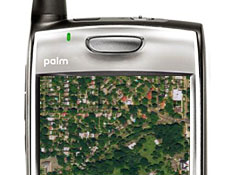 Clicking on an icon provides more address information and a button to phone them up, as well the ability to get turn by turn driving directions to and from any given point.
Clicking on an icon provides more address information and a button to phone them up, as well the ability to get turn by turn driving directions to and from any given point.